Early Church History Timeline:
30 - 400
30 - 400
[Liberty students: While this timeline will give you a greater understanding of this time period, you are not responsible for additional information on the quiz. The quiz will only come from information in the textbook.]

No. The first church building discovered dates from the mid-200's. Before then, Christians usually meet in people's homes, called house churches. II and III John are examples of letters written to house churches.
- Gnosticism had many forms, but it did have three main ideas:
- Multiple gods formed a hierarchy (or "ladder" of importance)
- The highest god can be thought of as the spiritually purest god (or the "good" god). Different gods or spirits exist below it, with a "lower" or even evil god being responsible for creating physical-ness (meaning the universe).
- Anyone who wanted to develop a spiritual life focused on this highest god. These people were known as "Gnostics."
- Docetism is an offshoot of Gnosticism. It developed when some Gnostics wanted to merge their "faith" with Christianity. It taught that
- The highest god sent a messenger to earth to teach spiritual truth.
- Jesus was that messenger sent from the highest god.
- Since Jesus was a messenger from a purely spiritual god, that meant that he was spiritual and not physical. He appeared to be physical but was not; this state has been called a "phantom." This is why this belief is called "Docetism." "Docetism" comes from Greek and means "to seem."
- While Nero's persecution was the first Roman persecution of Christians, it did not occur for religious purposes nor was it empire-wide but only localized around Rome.
- The first empire-wide persecution of Christians because of their faith in Jesus did not occur until the 90s with Domitian.
- After Domitian, persecution of Christians was sporadic due to the Trajan letter (see the year 112).
- The first systematic, widespread, Roman persecution of Christians did not occur until the mid-third century.
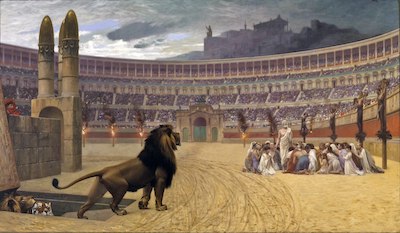
- More details: Many Christians use a fish symbol for Christianity; how did that start? Go here.
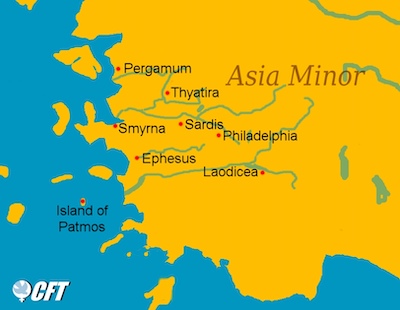
Early Christianity developed through four eras, which overlapped. They are, in order: the Age of the Apostles (Apostolic Age), the Apostolic Fathers, the Apologists, and the Teachers. These groups of leaders reflect changes that occurred in the early church period.
- Right after Jesus, the Apostles were tasked with carrying the word of God to the ends of the world.
- The Apostolic Fathers, provided leadership in making decisions about practical and even theological ideas in the young and growing churches.
- The Apologists, defended the faith.
- The Teachers, developed theological ideas of Christianity more fully. In this last group, we see the beginnings of the Councils.
The time period from Jesus to the late First Century is known as the Age of the Apostles. The next era in Church History is known as the Apostolic Fathers. These Christians were the next generation of leaders and helped solidify the new churches and church leadership. (I wish they would change the name because they were not the fathers of the Apostles.) Think of the Apostles as the founders of a corporation and the Apostolic Fathers as the later CEOs who run the corporation. The Apostolic Fathers wrote books which helped determine how churches operated and even discussed some theological ideas. The Apostolic Fathers are Clement of Rome, Ignatius, Shepherd of Hermas, Polycarp, and Papias, and the writings of the Epistle of Barnabas, the Epistle to Diognetus, II Clement, and the Didache. To read a short description of each, go here.
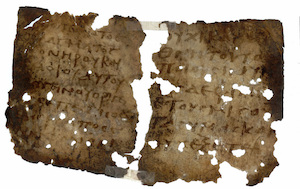
The Didache one of the Apostolic Fathers writings, was written in the early second century,and this is the earliest portion we have of the it, which dates to the fourth century.
Approximately 125 writings appeared in the 120 years after Jesus that claimed to be Christian. Most of these were heretical or were made up (which we would call "fake news"). These books are known collectively as New Testament Apocrypha. Please note: The Apostolic Fathers are not considered NT Apocrypha because, while not in the NT, they were truthful writings from church leaders after the time of the Apostles.
- Extra: A great story about the Apostle John when he was a very old man in Ephesus (after he was released from Patmos). (This story is not in the Bible, but it could be true): John, as a very old man, had many visitors. Christians traveled from great distances to see the last living original Apostle. They also asked John many questions. But John always gave the same answer: "Love one another." Eventually someone was brave enough to ask John why he didn't answer the questions. John replied, "Because if you love one another, the questions don't matter."
From the time of Jesus to the end of the Fourth Century, Christianity developed as an institution. Three aspects undergirded Christianity: the Canon, Creed, and Clergy. Think of it this way:
- The Canon , or Scripture, was the message given to the Apostles from God by inspiration of the Holy Spirit. It was the standard by which to measure true Christian faith and practice.
- But who was to define and interpret the faith? The Clergy.
- In addition, the Canon is long (think Old and New Testaments) and so an abridged or shortened version of the major teachings was needed.this was the Creed. Why was an abridged or shortened version necessary? Two reasons: to quickly defend against heresies--once you have a Creed you can immediately see where a heresy is wrong--and to serve as instructions for new Christians.
- In one of Ignatius' seven letters, the letter to Smyrna, he used the term "catholic," which means "universal" or "complete". This is the first time "catholic" was used to describe the Church. This did not refer to the Roman Catholic Church, which did not develop until later.
- Development of Clergy: Ignatius, bishop of Antioch, in a letter to the churches in Smyrna, wrote "Let no one do any of the things required of the church without the bishop. Let that be considered a valid Eucharist which is celebrated by the bishop, or by one whom he appoints. . . . It is not lawful either to baptize or to hold an agape [Christian "love feast"] without the bishop; but whatever he approves, this is also pleasing to God, that everything which you do may be secure and valid."
The word "apology" technically means "a defense." Christian apologists were people who defended Christianity against heresies and literary attacks and rumors. By the middle of the second century, Christianity had become so prominent that non-Christian thinkers began to attack the central ideas of Christianity in an attempt to destroy it. Therefore, Christian apologists were men who wrote responses which defended the faith. Among the most prominent Christian apologists were Quadratus (d. 124), Tatian (d. c.160), Justin Martyr (d. 165), Theophilus (d. c. 175), Athenagoras (d. 2nd Century), Aristides (d. 2nd Century), and Tertullian (d. c.225)
The veneration (adoring and honoring) of relics dates at least from this time. Polycarp's body was burned and his bones were venerated as relics. From a letter written in 156, “We took up the bones, which are more valuable than precious stones and finer than refined gold, and laid them in a suitable place, where the Lord will permit us to gather ourselves together, as we are able, in gladness and joy, and to celebrate the birthday of his martyrdom.” In later times, and especially in the Middle Ages, relics become a very important cause of pilgrimages. The Second Council of Nicea in 787 pronounced that everyone should venerate relics and that no altar should be consecrated unless it contained a relic.
Montanus taught that the age of the Paraclete (or Holy Spirit) had come and that the Paraclete spoke through him, giving him teachings beyond what the Apostles taught. He wanted those new instructions taught in churches. Therefore, he was seen as a threat to Christian Scriptures like Marcion was (see above, year 144). The difference: Marcion wanted the Christian Scriptures to be smaller and Montanus wanted them to be larger and include his teachings. Montanus and two others, Maximulla and Priscilla, also claimed to be able to forgive sins. This movement spread from Asia Minor into Europe and North Africa. It was eventually condemned as a heresy and died out after a couple of centuries.
Over a period of almost 200 years (c. 170 to 367), four different Christian authors compiled lists of Christian books that they believed were inspired. These four were the Muratorian List and the lists of Origen, Eusebius, and Athanasius. Go here to see their lists side-by-side.
- More details: To find out more about the myth of Mary and Panthera (a rumor circulated that he was the father of Jesus), go here.
The blood of the martyrs is the seed of the church.
Trinityto describe the Godhead. This is the first time that the word
Trinitywas used to describe God in a Christian sense.
- More details: To learn more about the development of the word "Trinity," click here.
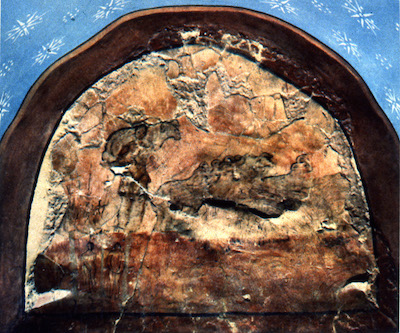
The first house church in Dura-Europos had several frescos.
This one is of Jesus as a shepherd carrying a sheep.
(Look just to the left of the center.)
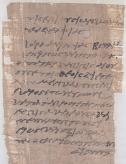
A certificate from the Decian Persecution
stating that the owner has sacrificed to the gods.
The view of Christianity from sometime in the First or Second Century to the split between Catholics and Orthodox in 1054 was that of one Church which comprised all Christians. Or, to put it another way, if you were not part of the Church, you were not a Christian. Cyprian's definition of the Church above (year 251) encapsulated the idea of all Christians under one banner. So by the mid 200s, the idea of one common Christian faith, i.e. the Church, gained prominence. Therefore, by the mid-200s church leaders can make decisions which cut across Christianity about what to do with those who bowed under persecutions, and in 325 a Council of church leaders can be called, the Council of Nicaea, which defined what one has to believe in order to be a Christian. But the Christianity did not have one person who is over all Christians, meaning the pope. That idea does not begin to develop until the period of 400-600.
- The Sinaiticus almost became part of a fire to heat a stove. Find out the fascinating story here.
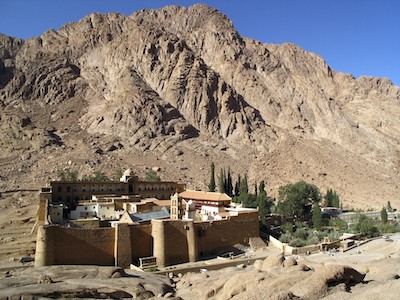
The Sinaiticus was discovered at the monastery at the foot of the Mt. Sinai.
It is called Saint Catherine Monastery and dates from the fourth century.
- More details: To read a short history of Christian persecutions, go here.
The Catholic, Orthodox, and Anglican Churches all have monks and nuns, which began with the Egyptian desert monks. The answer to the question of why people began to withdraw into the desert cannot be fully satisfied. Part of the reason includes a discontent with Christianity as it became more widely accepted and mainstream, the availability of a large space (the desert) which could be readily accessed and where one could be isolated (unlike in southern Europe), and a desire to fully surrender to God in an age when persecutions had ended (you could no longer be put to death for being a Christian after but you could die to yourself in the form of being a monk or nun). The two monks given credit for initiating the two types of monasticism, solitary or eremitic and communal or cenobitic, are Antony (see the year 285; eremitic) and Pachomius (see the year 320; cenobitic).
- Two types of martyrdom developed. Those killed for their faith experienced
red martyrdom.
. Those who died to their human desires by becoming monks and nuns experiencedwhite martyrdom
. - These groups of monks left a number of sayings behind; go here

Bust of Constantine
- This was the first of the twenty-one major Church Councils.
- Councils or meetings had been held before between several or a number of leaders, but this was the first one to include all Christian leaders.
- Around 300 Christian leaders attended from near and far; one "John of Persia" signed his name and wrote that he was head of all churches in Persia and India.
- The main issue dealt with in the Council was a debate initiated by Arius, who denied the divinity of Jesus. Arius believed that Jesus was created by God and was therefore not eternal nor divine on the same level as the Father. The debate was reduced to a choice of words: should the word “homoousios” (of the same nature) or
homoiousios
(of the similar or like nature; preferred by the Arians) be used to describe Christ; the former was chosen. - The Nicene Creed developed within the Council to defeat Arius' thought. Arius, who attended, refused to sign the Creed. To read the Creed, including the portion which ostracized the Arians, go here. The Creed would be enlarged at the Council of Constantinople in 381. See that year to read the Creed.
- One of the decisions at the Council was the dating of Easter. To read more, go here.
- More details: The Sinaiticus almost became part of a fire to heat a stove. Find out the fascinating story here.
Diocletian (emperor to 305 and died in 313) realized that the Roman Empire was too large for one person to control and so divided the Empire between the rule of two emperors; one controlled the western part of the Empire and one the eastern part. Constantine felt he was strong enough to rule the entire empire yet moved his capital eastward from Rome to Constantinople; this may have reflected growing concern for the stability of the eastern front of the Empire. The Empire vacillated between rule by one emperor and two until 394, when Theodosius became the last sole emperor of the entire Empire. Upon his death, the Empire was divided between Theodosius' two sons. This divide in the Empire reflected differences between the two halves of the Empire which existed well before 394. Eventually these differences would help result in Christianity splitting into western and eastern Christianity: Catholicism in the West and centered in Rome and Orthodoxy in the East and centered in Constantinople. And it remains that way today.
With Constantine, Christianity saw its first imperial protector. Because of this, Christianity itself changed in style. Christians were no longer persecuted during his reign. More people became Christian, more resources were spent on building churches, Christians--no longer fearing for their lives--spent their effort in developing Christian thought and understanding through education and writing, and the church services themselves developed more elaborate ceremonies, such as clerical dress (vestments) during the service, incense, processionals before and after the worship service, and choirs.
© 2020 Mark Nickens